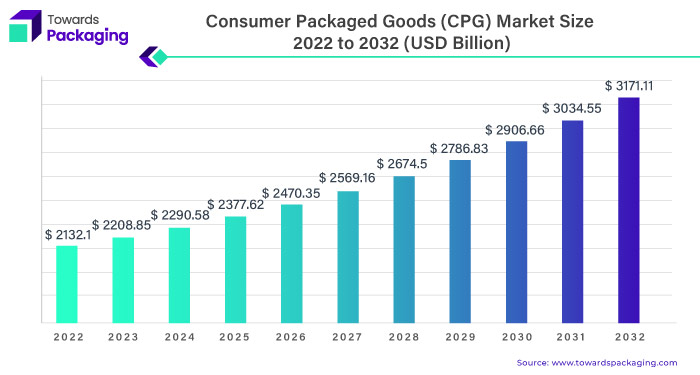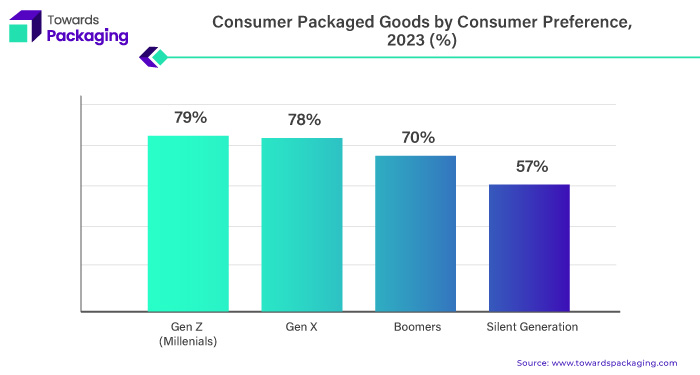Report Highlights: Important Revelations
- The global consumer packaged goods (CPG) market is anticipated to witness substantial growth, with an value of USD 2,132.1 billion in 2022.
- This growth trajectory is projected reaching an value of USD 3,171.11 billion by the year 2032.
- Over the period from 2023 to 2032, the market is expected to experience a CAGR of 4.1%.
- Interconnected markets driving consumer packaged goods companies to explore international opportunities.
- North America’s CPG industry commands a $2 trillion valuation.
- Asia Pacific’s consumer package goods set to expand rapidly by 2030.
- Food and beverage reigns supreme in consumer packaged goods sales.
- Consumer packaged goods companies prioritize large offline retailers in operations.

Consumer Packaged Goods (CPG) Market Overview:
-
- CPGs are essential for daily life, ranging from food and beverages to apparel and cosmetics.
- The sector shows robust growth with an 8% year-over-year increase, reaching a projected $1.62 trillion in annual sales.

Interconnected Markets Driving Consumer Packaged Goods Companies to Explore International Opportunities
- CPG products, from food and beverages to personal care items, constitute essential and routine consumer purchases, driving consistent demand.
- The perishable nature of many CPG goods and the routine consumption patterns necessitates regular replenishment, ensuring a continuous market demand.
- The broad spectrum of CPG offerings, including food, clothing, cosmetics, and household items, caters to a wide range of consumer needs, expanding market reach.
- Shifting consumer preferences and evolving lifestyles influence the types of CPG products in demand, prompting innovation and adaptation by manufacturers.
- Technology integration in manufacturing, distribution, and marketing processes enhances efficiency, reduces costs, and improves overall supply chain management for CPG companies.
- The rise of online shopping platforms provides consumers convenient access to a wide array of CPG products, reshaping traditional retail dynamics and expanding market accessibility.
- Increasing health and wellness awareness influences consumer choices, driving demand for healthier food options, organic products, and environmentally friendly packaging within the CPG sector.
- As markets become increasingly interconnected, CPG companies are exploring global opportunities, leading to the expansion of their product distribution and market presence.
- Growing environmental consciousness among consumers propels CPG companies to adopt sustainable practices, including eco-friendly packaging, reducing emissions, and incorporating responsible sourcing.
Sustainability Initiatives:
-
- CPG companies are adopting sustainability practices, particularly in packaging, to reduce environmental impact.
- Holistic sustainability initiatives extend beyond packaging, including emission reduction and responsible sourcing.
Consumer Preferences Across Generations (2023):
-
- Millennials (Gen Z) show the highest preference for CPG products (79%).
- Generation X closely follows with a preference of 78%.
- Boomers also have a substantial preference (70%), while the Silent Generation shows a relatively lower preference (57%).
Interconnected Markets Driving CPG Opportunities:
-
- CPGs, being essential, drive consistent demand with routine replenishment.
- A broad spectrum of CPG offerings meets diverse consumer needs, expanding market reach.
- Technology integration enhances efficiency, while online platforms reshape retail dynamics.
Consumer Packaged Goods (CPG) Market Trends (2023):
-
- Significant shift towards online marketing and e-commerce.
- Embrace of eco-friendly practices, including sustainable packaging.
- Direct-to-consumer expansion for enhanced brand loyalty.
- Prioritization of supply chain resilience to mitigate risks.
North America’s CPG Industry ($2 Trillion Valuation):
-
- North America’s CPG industry is valued at $2 trillion.
- Industry leaders like Coca-Cola, Procter & Gamble, and L’Oréal play key roles.
- Increased marketing expenditures, with 23% of CPG budgets dedicated to marketing initiatives.
Global Expansion and Opportunities in Asia:
-
- Asia’s consuming class is rapidly expanding, with 3 billion individuals (70% of the population) projected to join by 2030.
- Projections for specific countries like Indonesia and India show substantial growth in the consuming class.
- Higher-income consumers are expected to lead future consumption growth.
Food and Beverage Dominance in CPG Sales:
-
- Food and beverage represent 44% of online CPG sales, generating a projected $26,774 million in revenue.
- Ongoing challenges include raw material shortages, production delays, and increased costs.
Offline Retail Dominance:
-
- Large offline retailers dominate CPG transactions, with $297 average spending on food and beverage products.
- Online spending is growing but remains at $64, highlighting the enduring significance of physical retail channels.
Top 10 Consumer Goods Companies (2023):
-
- Nestlé, PepsiCo, LVMH, Procter & Gamble, JBS, Unilever, AB InBev, Tyson Foods, Nike, and Coca-Cola lead the industry.
- Competition involves innovation, sustainability, and adapting to changing consumer preferences.
Recent Developments and Market Segments:
-
- Chobani acquires La Colombe for $900 million.
- Mars acquires UK Chocolate Brand Hotel Chocolat.
- General Mills establishes Fera Pets through the acquisition of Veterinarians.
- e.l.f. Beauty purchases Naturium for $355 million in shares and cash.
Consumer Packaged Goods (CPG) Market Segments:
-
- Segmentation by application includes food and beverage, household supplies, personal care, and cosmetics.
- Distribution channels include online and offline.
- Regions covered are North America, Europe, Asia Pacific, and LAMEA.






Leave a Reply